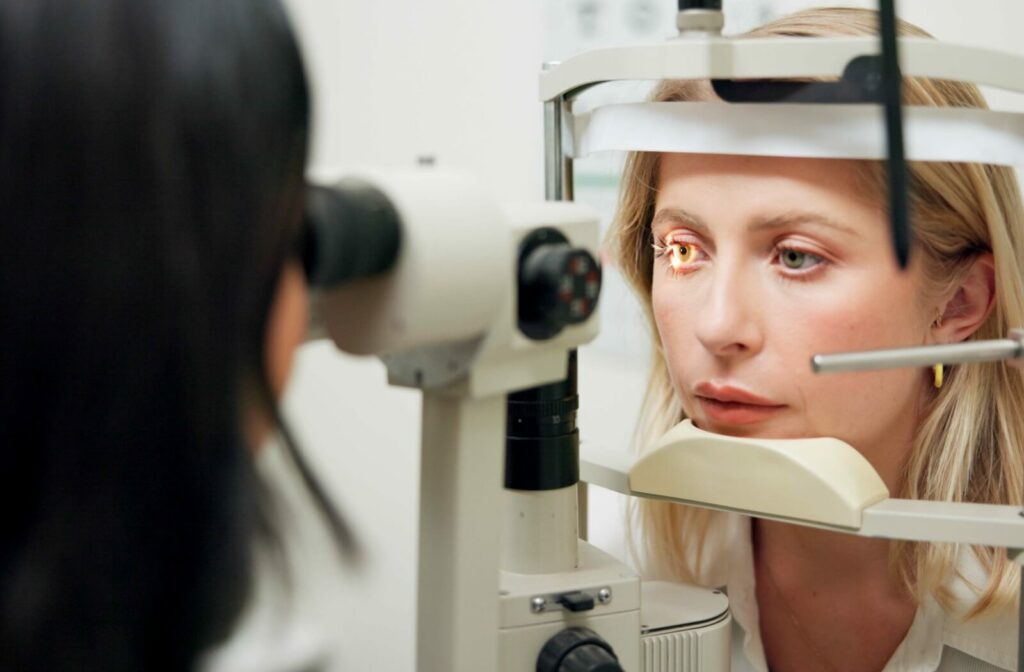Wearing contact lenses can be a game-changer, offering freedom from glasses and a more natural field of vision. However, even experienced contact lens users know the occasional moment of panic when wondering, “Did my lens fall out, or is it still stuck in my eye?”
Take a deep breath and relax. It’s going to be okay! You can safely remove a dislodged lens at home, provided, of course, you know a contact lens is actually stuck, and you can locate it.
Some telltale signs that a contact lens is stuck in your eye generally include:
- Discomfort or irritation
- Watery eyes or redness
- Blurry vision
- Feeling as though something is in your eye
Never feel embarrassed to visit your eye doctor for something as seemingly simple as a stuck lens. We care about your comfort and safety!
Lost Lens? How to Tell If It’s Stuck
Sometimes, a contact lens doesn’t sit where it’s supposed to. Instead of comfortably resting on your cornea, it may shift to an unexpected part of your eye or even fold on itself.
If you’re unsure whether a contact lens is still in your eye, here are some telltale signs:
- Discomfort or irritation that feels like a foreign body, leaving your eyes feeling scratchy, dry, or irritated
- Excessive tearing or redness is often your eye’s natural reaction to a misplaced foreign body
- Blurry vision in one eye, indicating one of your lenses has wandered off
First things first, if you feel your contact lens is stuck in your eye, stay calm! Resist the urge to panic or rub your eye. Rubbing can cause further harm by potentially tearing the lens and it will cause inflammation further irritating the eye.
Playing Detective: Locating Your Lost Lens
If you suspect the missing contact lens is still in your eye (and hasn’t fallen out), locating the lens is a must before attempting removal.
Wash your hands first. Avoid using unclean fingers or non-sterile materials to “search” for the lens, as this can increase your risk of infection.
Look in the mirror and use plenty of light. Gently pull down your lower eyelid and look beneath it. Similarly, lift your upper eyelid and inspect for any signs of the lens.
When in doubt, blink. Sometimes, blinking can help reposition the lens or dislodge it slightly, making it easier to spot. Blink several times and use artificial tears to add moisture and help relieve irritation.
Move your eyes in every direction (up, down, left, and right). Sometimes, movement can help dislodge or allow you to feel the lens.
Feel for it, but gently. Wash your hands thoroughly. Then, gently touch around the surface of your eye. A soft, smooth surface might indicate folded or displaced contact.
Can’t Find Your Lens? It’s Time to Get Professional Help
If you’ve tried the above steps and can’t locate your lens, it might already have fallen out. However, if discomfort continues, there’s a chance it’s stuck in a less visible location, like under your upper eyelid.
The good news: Your lens can’t travel farther back than the eye’s surface thanks to a protective tissue layer called the conjunctiva. It’ll wait for you to get professional help.
When you can’t locate your missing lens, the safest action is to visit your eye doctor. They have the tools and expertise to safely determine if the lens is in your eye and remove it without increasing irritation.

Gently Does It: Safely Removing a Stubborn Contact Lens
If you’ve located your contact lens and feel confident removing it on your own, proceed with caution. Rushing or improper handling can further irritate or damage the eye.
Take a deep breath, and slowly but gently, try and remove the lens:
- Wash and dry your hands
- Always start with clean, dry hands to maintain eye hygiene
- Rehydrate your eye with a few drops of artificial tears
- Hydration often helps dislodge sticky lenses more easily
- Look in a mirror & use a well-lit area
- Pull down your lower eyelid or lift the upper one, depending on where the lens is stuck
- Slide the lens to the center
- Use a clean fingertip to gently guide the lens back to the center of your eye for easier removal
- If the lens is folded, gently try to unfold it
- Pinch & remove once the lens is in position
- Softly pinch & remove the lens from your eye
- Avoid pressing too hard on your eye
Do not overexert yourself if the lens feels stuck, as this could lead to further irritation. It’s not a race, so take breaks if you need to. If the lens remains stubborn, don’t hesitate to call your optometrist for help.
If removing the lens is successful, the next step is to inspect it for damage, such as scratches or tears. Discard the lens immediately if you notice any damage, and avoid reinserting the lens into your eye.
Give your eye enough time to recover. Wear your stylish backup glasses. Avoid inserting a new contact lens for at least a few hours, or until the irritation has subsided. Use artificial tears as needed to alleviate any discomfort or dryness.
The Risks of Leaving a Contact Lens in Your Eye
Leaving a stuck contact lens in your eye and hoping it dislodges on its own isn’t worth the trouble. The consequences go beyond temporary discomfort and could pose risks to your long-term eye health, including:
- Scratches (corneal abrasion)
- A misplaced or dry lens can cause scratches on your cornea, leading to irritation or more serious complications
- Eye infection
- A stuck lens can trap bacteria and dirt, creating ideal conditions for infections like conjunctivitis (pink eye)
- Swelling or redness
- Persistent irritation may cause swelling or even lead to corneal inflammation (keratitis)
Protect Your Vision & Keep Your Eyes Happy
A stuck contact lens may seem like a tricky situation, but with the proper knowledge and precautions, you can resolve it without compromising your eye health. The key is to act calmly, follow safe steps, and seek professional help if needed.
Don’t hesitate to connect with The Vision Place for experienced care and advice if discomfort or concerns continue. We’re here to keep your contact lens experience stress-free.


